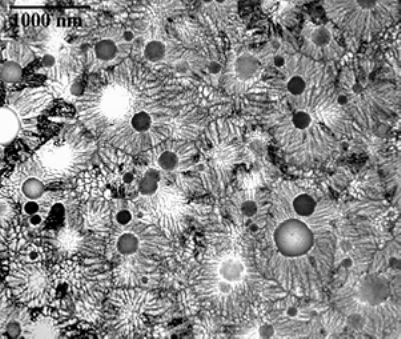Molten metal solidifies into a new kind of glass

(Phys.org) —When a molten material cools quickly, parts of it may have enough time to grow into orderly crystals. But if the cooling rate is too fast for the entire melt to crystallize, the remaining material ends up in a non-crystalline state known as a glass, with atoms caught in place essentially as a frozen liquid.
Recently, a group of researchers at the National Institute of Standards and Technology (NIST) came across an unexpected reversal of this usual sequence of events.
After cooling a molten alloy of aluminum, iron, and silicon, they found that glassy nodules of a non-crystalline solid phase formed first, growing slowly enough to organize and select some chemical species, rejecting other species into the surrounding melt that, on further cooling, coalesced into crystals.
Investigation of the new phase at the U.S. Department of Energy Office of Science's Advanced Photon Source (APS) suggests that it may be an example of a novel structure, theoretically possible but not seen until now, that is isotropic, with infinite rotational symmetry, but lacking any discrete translational symmetry.
Direct visual evidence (see the figure) indicates that the nodules formed first, followed by metallic crystals radiating around them. Closer inspection revealed that the radiating white bands are crystalline aluminum with small amounts of iron and silicon. The nodule composition is approximately Al13Fe3Si4.
The researchers concluded that the nodules formed by nucleation and displaced excess aluminum as they grew; eventually, the aluminum concentration in the surrounding material was high enough that the remaining melt crystallized, pushing residual iron and silicon into the gaps.
Electron microscopy showed that the material in the nodules is isotropic, leading the researchers to call it "q-glass," despite the fact that it does not form as glasses normally do.
To investigate its structure further, researchers from NIST and Argonne National Laboratory went to X-ray Science Division (XSD) beamline 1-ID-C at the Argonne APS to obtain high-energy x-ray scattering data with which to compare samples of the q-glass to two other known phases of Al-Fe-Si with composition similar to that of the q-glass: the crystalline cubic ?-phase and the quasicrystalline icosahedral phase.
Diffraction of 80-keV x-rays yielded data that the team analyzed using pair distribution function (PDF) methods, which show a series of peaks corresponding to distances between pairs of atoms.
The PDFs for all three samples were roughly similar up to pair distances of about 12 Å, with the pattern for the q-glass closer to that of the ?-phase than to the icosahedral phase. Beyond 12 Å, the two crystal phases continued to show peaks corresponding to long-range correlations in atomic position over distances greater than the size of the ?-phase unit cell. But the PDF for the q-glass mostly fizzled out, showing a lack of longer-range order and therefore an absence of true crystal structure.
That result left open the possibility of the q-glass being nanocrystalline, consisting of many tiny and randomly oriented ?-phase crystals. To explore that possibility, the researchers went to XSD beamline 11-ID-B at the APS, again using high-energy x-ray scattering to study how the x-ray diffraction pattern of the q-glass changed as the sample was heated. If the q-glass were nanocrystalline, prolonged heating should cause the crystals to coarsen, so that the structure as a whole would come to more closely resemble a polycrystalline ?-phase.
That's not what happened. When the q-glass was held at 330° C, its diffraction pattern stayed the same for about 40 minutes, at which point it changed rapidly into a pattern characteristic of a new phase, ?-Al4.5FeSi.
The lesson is that the q-glass structure is a true phase that will transform into a different phase at the appropriate temperature.
If the q-glass is not crystalline, quasicrystalline, or polycrystalline, what is it?
The researchers point to two general possibilities. One is frustrated growth from an initial seed that results in a structure with clusters that pack stably together, but in a disordered way that breaks up long-range order.
More exotically, there are mathematically permissible arrangements of points in three dimensions that are isotropic with neither periodicity nor quasiperiodicity.
Lead researcher Gabrielle Long, of Argonne and NIST, says the team has sent their data to an expert who maintains a "zoo" of theoretically feasible structures.
"It would be interesting if theorists have imagined this thing," she says. "We want to see if any 'animals' exist that fit what we see."
Discoveries such as this will be taken to even newer frontiers by the high-energy x-rays to be produced by the upgrade of the APS x-ray source and beamlines, now under way at Argonne.
More information: Gabrielle G. Long et al. "A Highly Ordered Non-crystalline Metallic Phase," Phys. Rev. Lett. 111, 015502 (2013). DOI:10.1103/PhysRevLett.111.015502 prl.aps.org/abstract/PRL/v111/i1/e015502
Journal information: Physical Review Letters
Provided by Argonne National Laboratory











.jpg)









